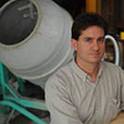Article
Load Transfer Efficiency of Rigid Airfield Pavement: Relationship to Design Thickness and Temperature Curling
Transportation Research Record
(2012)
Abstract
FAA uses a mechanistic design procedure, FAA Rigid and Flexible Iterative Elastic Layer Design (FAARFIELD), for the design of rigid airport pavements. FAARFIELD does not consider curling stresses in determining the portland cement concrete (PCC) layer thickness and assumes constant stress-based load transfer efficiency [LTE (S)] of 0.25 at the joints. Recently completed studies have shown that LTE (S) values under moving aircraft loads can be significantly higher than 0.25. In addition, the curling stresses, induced because of the temperature differentials at the top and bottom of the PCC slab, can affect the load transfer efficiency at the joint. Higher curling stresses can lead to higher combined stresses (loading plus curling) in pavements. The objective of this study is to analyze the effect of load transfer efficiency and loading intensity on PCC design thickness and the effect of PCC temperature gradient on LTE (S) and critical edge stresses. The results indicate that for a slab that shows no curling, an increase in LTE (S) value by 0.10 would reduce the PCC design thickness by 1.3 in. (33 mm) under FAA design procedures. In addition, when the top of the slab has a higher temperature than does the bottom of the slab, higher stresses at the joint and higher LTE (S) are observed. The variations in temperature gradient induce curling stresses in the slab and affect the LTE (S) at the joints.
Disciplines
Publication Date
January 12, 2012
DOI
10.3141/2300-08
Citation Information
Akshay P Joshi, Yusuf A Mehta, Douglas Cleary, Samuel Henry, et al.. "Load Transfer Efficiency of Rigid Airfield Pavement: Relationship to Design Thickness and Temperature Curling" Transportation Research Record Vol. 2300 (2012) p. 68 - 74 Available at: http://works.bepress.com/douglas-cleary/12/
